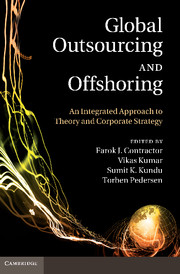Book contents
- Frontmatter
- Contents
- List of figures
- List of tables
- List of boxes
- Notes on contributors
- Preface: the reconfiguration of the world economy
- Part I Conceptual frameworks and theories
- Part II The offshoring and outsourcing of R&D and innovative activities
- 4 Blurring firm R&D boundaries
- 5 Outsourcing, fragmentation, and integration
- 6 Towards a better understanding of multinational enterprises' R&D location choices
- 7 Does R&D offshoring displace or strengthen knowledge production at home? Evidence from OECD countries
- 8 Innovation across tech-firms' boundaries
- 9 Suitable organization forms for knowledge management at various R&D functions in decentralized and cooperative R&D networks
- Part III Management issues in offshoring and virtual teamwork
- Part IV Empirical analyses and case studies of outsourcing and offshoring
- Index
- References
6 - Towards a better understanding of multinational enterprises' R&D location choices
Published online by Cambridge University Press: 10 January 2011
- Frontmatter
- Contents
- List of figures
- List of tables
- List of boxes
- Notes on contributors
- Preface: the reconfiguration of the world economy
- Part I Conceptual frameworks and theories
- Part II The offshoring and outsourcing of R&D and innovative activities
- 4 Blurring firm R&D boundaries
- 5 Outsourcing, fragmentation, and integration
- 6 Towards a better understanding of multinational enterprises' R&D location choices
- 7 Does R&D offshoring displace or strengthen knowledge production at home? Evidence from OECD countries
- 8 Innovation across tech-firms' boundaries
- 9 Suitable organization forms for knowledge management at various R&D functions in decentralized and cooperative R&D networks
- Part III Management issues in offshoring and virtual teamwork
- Part IV Empirical analyses and case studies of outsourcing and offshoring
- Index
- References
Summary
Introduction
Economic globalization and the emergence of attractive new regions for the location of economic activities have led many multinational enterprises (MNEs) to review their location strategies, in order to optimize their global value chain. In particular, recent years have seen a growing internationalization of Research and Development (R&D). Historically, R&D has typically been based close to the center of the firm's operations, because it is considered a highly strategic activity. Recently, there is growing evidence that MNEs are moving to a more dispersed approach to the firm's innovative capacity, and are increasingly locating R&D units abroad (Doh et al., 2005). According to the United Nations Conference on Trade and Development (UNCTAD, 2005), MNEs, which account for half of all worldwide expenditure on R&D, now conduct 28 percent of their R&D abroad. This movement towards internationalization is emphasized by the fact that emerging countries are becoming increasingly attractive destinations for the location of R&D activities. Researchers and specialists expect this trend to become more marked in the coming years (Cantwell and Janne, 1999; Dunning and Narula, 1995), with these activities increasingly based in emerging economies (UNCTAD, 2005). This recent development in the R&D function raises the question of how MNEs manage their high value-added innovative activities, particularly their location choices.
Researchers have identified firm-level and industry-level characteristics that guide the Foreign Direct Investment (FDI) decisions of the world's largest firms (Nachum and Zaheer, 2005; Terpstra and Yu, 1988).
Information
- Type
- Chapter
- Information
- Global Outsourcing and OffshoringAn Integrated Approach to Theory and Corporate Strategy, pp. 168 - 190Publisher: Cambridge University PressPrint publication year: 2010
References
Accessibility standard: Unknown
Why this information is here
This section outlines the accessibility features of this content - including support for screen readers, full keyboard navigation and high-contrast display options. This may not be relevant for you.Accessibility Information
- 5
- Cited by
